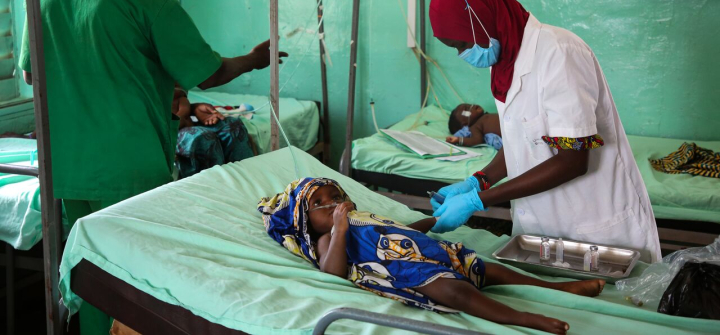Access to Medical Oxygen: A Breath of Fresh Air for Children Around the World
One may not immediately think of oxygen as being in short supply—it is an integral component of the air we breathe, after all. However, in much of the world, access to safe, purified medical oxygen is extremely limited.
When a patient arrives at a hospital with low levels of oxygen in their blood and difficulty breathing—common symptoms of a respiratory infection—oxygen therapy is a key intervention. But while medical oxygen is abundant in high-income countries, this lifesaving resource is scarce for millions of people all over the world. In low- and middle-income countries (LMICs), many health facilities’ capacity to provide oxygen therapy is limited by suboptimal infrastructure, equipment, and training.
Universal access to oxygen would save the lives of thousands of people worldwide, especially children, who are most at risk of dying from severe respiratory infections. When medical oxygen is unavailable, these young patients stand little chance of survival. For children under age 5 living in LMICs, lower respiratory tract infections like pneumonia are a leading cause of mortality. According to UNICEF, pneumonia alone kills more than 700,000 children under 5 each year, including more than 153,000 newborns.
The COVID-19 pandemic—during which access to medical oxygen could mean life or death for critically ill patients—exposed stark disparities in the availability of this precious resource and inspired action. The World Health Assembly endorsed a resolution in May to increase availability of medical oxygen worldwide, and the WHO has pressed its member states to prioritize the development of sustainable national oxygen systems.
What will it take to turn this resolution into reality?
The answer is not simple. Regions—typically rural ones—that lack production plants must rely on expensive, imported medical oxygen to treat patients. In urban areas that can produce oxygen, aging plants require repairs, access to parts, and engineers to perform critical maintenance work. In addition, a lack of reliable power sources poses challenges to the production and use of medical oxygen.
That is why the solutions to improve oxygen access in these regions—ensuring a reliable oxygen supply; identifying patients who require oxygen therapy; and training health care workers, technicians, and engineers on oxygen therapy and equipment maintenance—need to be as multifaceted as the challenges.
For years, ALIMA (the Alliance for International Medical Action) has been working with local partners to improve sustainable access to medical oxygen in countries including Mali, Niger, Guinea, Sudan, and Burkina Faso. We do this by providing equipment, technical expertise, and training to health care workers and technicians. Training spans topics and skills from oxygen therapy to maintenance of equipment to supply chain management. We see the benefits of this work every day. More children live longer, and health systems get stronger and better prepared for future pandemics.
Now, the world needs the collective will to address inequality in oxygen access across the globe.
The global health community needs to invest in sustainable and secure access to medical oxygen. Partnerships between sectors are key to moving this work forward. Local governments, funders, the private sector, and humanitarian groups all have a part to play—from providing dedicated resources to prioritizing the building of needed infrastructure. While ALIMA and its partners are working to address this inequity, much more needs to be done so that children around the world can live long, vibrant lives.
Ahead of World Pneumonia Day on Sunday, I am reminded of this persistent health inequity, and hopeful for a future where no child must struggle to catch their breath because of where they live.
Marine Vignon is the AIRE project manager at Alliance for International Medical Action (ALIMA), where she leads the organization’s oxygen initiatives and research.
ALIMA is a medical humanitarian organization based in Dakar, Senegal that focuses on building alliances and promoting collaboration between local health workers, national medical organizations, and researchers.
Join the 50,000+ subscribers in 170+ countries who rely on Global Health NOW summaries and exclusive articles for the latest public health news. Sign up for our free weekday newsletter, and please share the link with friends and colleagues.
Pediatric nurse Mahawa Diabaté treats 17-month-old Djeneba Mariko, who is placed on oxygen and treated for malaria and respiratory distress. Dioila, Mali, June 2022. Seyba Keita/ ALIMA




